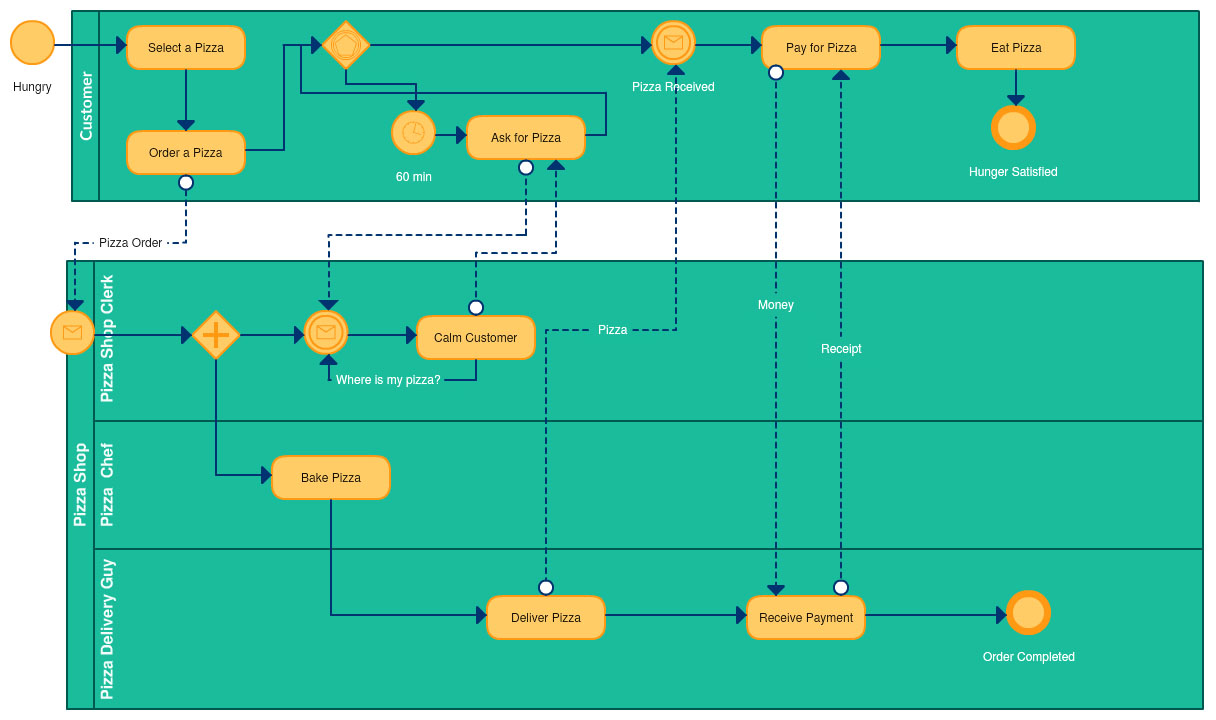
- #BUSINESS PROCESS MODELLING DIAGRAM VS ACTIVITY HOW TO#
- #BUSINESS PROCESS MODELLING DIAGRAM VS ACTIVITY SOFTWARE#
- #BUSINESS PROCESS MODELLING DIAGRAM VS ACTIVITY SERIES#
Lanes represent people or departments and the pool displays the sub-task.Īrtifacts: You can use artifacts when extra information unrelated to sequence or message flow needs to be added to explain a process. Sometimes a sub-task requires shared responsibility from multiple users, and swim lanes show how the workflow distributes the shared responsibilities.
#BUSINESS PROCESS MODELLING DIAGRAM VS ACTIVITY SERIES#
Swim lanes: Swim lanes provide arrangements for sub-tasks or compound activities that represent a series of other tasks. Symbols include solid lines which represent task transfers and dashed lines show messages. When connected, they display the order of events. Circles illustrate events, rectangles describe activities and diamonds refer to control points.Ĭonnecting objects: Connecting objects shows the connection between tasks. Symbols used to represent the flow include circles, rectangles and diamonds.

Here is a list of the standardized BPMN symbols:įlow objects: Flow objects show how the process flows. There are many standardized symbols that exist to make collaboration with analysts outside of your business more efficient, but you have the option to create any symbols you would like to represent your business process. Business process modeling notationīusiness process modeling notation (BPMN) comprises symbols used to represent different tasks and workflows within a company. Here are some examples of techniques used today: 1. The technique you choose to use when creating process models may depend on the complexity of your business process, whether there are multiple tasks happening at once and your staff's general understanding of different business process modeling approaches. This can be helpful in creating a sense of accountability during each step of a process.Īdds flexibility: Variables in an ongoing process can change quickly and make it less efficient, so using business models may aid in having alternative processes ready to be used if something in the current process changes and is no longer viable. These redundancies are sometimes easier to notice when looking at the entire process through process modeling and you can then remove them from the process altogether.Ĭreate transparency: Business models can show who is accountable for each task, how and when employees perform their tasks and how the process contributes to the organization's success. Remove redundant tasks: Some tasks in the process may become unnecessary. Once you have identified those areas, you can make efforts to remove, add or alter additional steps to improve the efficiency of the workflow. Improve efficiency: Business process modeling can help improve production efficiency by finding areas that slow down the process.
#BUSINESS PROCESS MODELLING DIAGRAM VS ACTIVITY HOW TO#
If you've got a business process model in place, you can train new staff using the visual aid so they know exactly how to perform their part of the process for favorable results. Here are a few reasons an organization may use business process modeling:Ĭreate process repetition: You can ensure that your team can repeat successful processes the same way every time.

Related: 6 Methodologies You Can Use For Business Process Improvement Why use business process modeling?
#BUSINESS PROCESS MODELLING DIAGRAM VS ACTIVITY SOFTWARE#
Companies typically use software to go through each step of a process more swiftly and can more effectively improve their ongoing systems. There are many business process modeling techniques that your business can implement to better understand your business processes, such as flowcharts. Related: The 10 Key Components of a Business Model What is business process modeling?īusiness process modeling outlines all the steps in your business process, giving you a way to examine your business's workflow with a visual guide. In this article, we discuss what business process modeling is, why companies use it and provide seven business process modeling examples. Using models can provide a clear understanding of how a process works, produce ways to be consistent and establish a clear start and end to a process. Some businesses choose to implement business process modeling to determine ways to improve current processes used within their organization. Business process modeling is a visual demonstration of a business's different processes.


 0 kommentar(er)
0 kommentar(er)
